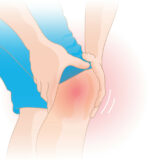What are triggerpoints or muscle knots?

The trigger point syndrome is a popular explanatory model for ongoing pain. It uses a local muscle knot in the muscle or in other words a triggerpoint as the reason for the pain. And this model says at the same time that you should treat it locally with manipulations, pressure or needles. These forms of treatment are being practised worldwide by health care professionals like physical therapists, chiropractors and various unlicensed and unregulated practitioners. But does the evidence support this model and way of thinking? Are triggerpoints real or are they fiction. In this blog you will find out if your “muscle knot” is a real trigger point or not!
This blog is going to ruffle a lot of feathers. Because besides the fact that I will discuss what trigger points or muscle knots are, I will also discuss a thing or two about dry needling therapy.
So many theories!
So let’s start with the first question, what are trigger points or muscle knots? Well, there have been a lot of different theories behind the trigger point concept. Trigger points are theorized to be chronic inflamed lesions of tissue, but there has also been a model that trigger points could set up a reflex that leads to an increase in muscle tension. Resulting in a cycle that could maintain your pain. So the muscle knot could maintain its own pain. But two people named Travell and Rinzler came up with an addition to this trigger point pain theory. They found out that people could also feel pain in muscles that aren’t linked to your current pain. So they stated that trigger points or areas can maintain pain cycles indefinitely.
Anatomical charts
But Travell didn’t stop there. She and Simons made anatomical charts of muscle knots and its referred pain patterns. But what are referred pain patterns? Well referred pain patterns are areas in which you can feel pain when you put pressure to those muscle knots. So the origin of the pain isn’t really localized in the area you feel the pain in. So they made charts. The reason why they did this, is because they believed that the pain people feel is divided in the sharp pain from a trigger point and the dull pain localized in a different region coming from the trigger point itself. And they wanted to make this easy and understandable with their charts.
Trigger points are pain generators!
So what are trigger points? Trigger points can be located with feelable strings or knots in muscles. And trigger points were believed to be cramped muscle fibers or just knots in muscles that had undergone tissue damage. But the fact that they could also be “felt” in muscles without lesions, made people a little bit hesitant about this theory.
The most recent theory behind trigger points are that they are peripheral pain generators that can arise within muscles. So the fibers of the muscles are more tender to influence from outside (pressure or tension for instance) or inside the body and can produce pain sooner than usual. This theory came out of a study from Shah et al from the year 2008 where they took tissue fluid within and near feelable trigger zones. They took these fluids from people with and without pain. And they found that trigger points have the same substances as found in people with over sensitization, so peripheral sensitization. And peripheral sensitization means that the tissue is more sensitive than usual. So trigger points aren’t cramped muscles, they are more likely to be linked to your pain sensation.
Can we even find them?
Self proclaimed experts say they can find them. But what can the evidence tell us about finding trigger points in people with muscle knots? Can we really find them? So luckily for us, they did multiple studies around this topic. And in these studies they asked examiners, who were self proclaimed experts on trigger points, to find the trigger points or muscle knot. And what they found during these studies was that palpating or finding trigger points was really hard and not reliable. So we can’t even reliably find trigger points.
Okay, so we can’t reliably find them when we try to search for them. But if they exist we should be able to see them on imaging. Well if we should believe the studies surrounding this topic, we can see trigger points. But don’t cheer yet. Because the quality of these studies is extremely low, in some studies the data isn’t present, they didn’t included pain free people and some studies even found trigger points in people with and without pain. So we can’t reliably feel and see the trigger points.
But you feel them on yourself right? You have those tender spots. So maybe they are active trigger points. We don’t really know. But we do know that they hurt. So how can we treat them?
Treating the trigger points
One of the most used treatments is a pressure technique. A technique where they would give pressure to the trigger point or taut band to dissolve the trigger point. Another technique is called dry needling where they puncture a needle through the skin towards a trigger point. So what does the evidence tell us about these techniques?
Well….. there is a lot of evidence, but nothing to back up dry needling or pressure techniques. Big systematic reviews, so studies where they combine smaller studies to get a full conclusion, found out that these techniques don’t help better than placebo needling or no treatment at all. So it doesn’t work right? Because that’s what the evidence tells us.
Not specific enough
But many people who follow yourphysio.online know that we are extremely critical. And that’s something that our followers like the most about us, being critical and giving true information. So if I may be really critical here. I just mentioned that we can’t really find or palpate trigger points, we don’t even know what they are right now. But we do know that people believe they are feeling them and that “they” can produce pain. So let’s say that we put a lot of people with non specific neck pain in a study. And believe me, that’s a really non specific diagnosis. And with non specific I mean that we don’t really know what the cause of their neck pain is. But we give them all dry needling or pressure techniques, because that’s what the pre written study method said we should be doing. We are probably giving people who don’t have “real” trigger points a treatment to treat trigger points. But can you imagine that if you give a non specific treatment to a non specific diagnosis, that you would get a non specific outcome? So it isn’t that strange that we don’t find great results from these studies.
And I don’t immediately say that we should all be using dry needling or that dry needling is great, absolutely not. Because I believe that treatment in a way of exercising, pain education and information is way more valuable than two needles in your neck or back. But if you would be giving it as a healthcare professional or if you want to get it as a patient, the dry needling should be done really specific to your complaint.
So how does dry needling work?
But what if you get dry needling as a treatment, how does it help you? First of all, we don’t really know. But if we believe trigger points are like tender spots that are influenced because of how you experience your pain, we could also theorize it around that model. If we give you a painful input, let’s say a needle through your skin or in an over sensitive area of your muscle. We can activate areas in your brain that can decrease your pain perception. So because of the painful input, so the needle, we feel less pain.
But maybe you feel less pain because you believe your healthcare professional, or you expect this treatment to resolve your problem. Because your expectation can also change your pain. In a video on our YouTube channel about how to beat chronic pain, I explained how your expectation can have an influence on your pain sensation. So if you haven’t seen that one, make sure you do!
So we can change your pain perception through needling your trigger points. Or is it just the puncture of the skin? Well studies have shown that it doesn’t even matter where you stick the needle and some studies even find that it doesn’t matter if you really puncture the skin. Pressure is enough.
Take back your control!
So we don’t really know why it works, and to be honest it doesn’t even care. As long as it works right. Well… NO. We as health care professionals want to give back control to your complaint. And sticking a needle in your back every session isn’t going to give you back your control. We want to change the way you think about your complaint. We want to give you information and advice and we want to make your body stronger so it can withstand more load. And to be honest, needles aren’t going to help with that. So instead of laying there and being treated with a couple of needles, try to find the real cause of your pain and work on that! And if you think you need some help with that, consider booking an online appointment with us at yourphysio.online. The link is down below.
Okay to sum things up. We don’t really know what the real theory behind the trigger points are. But at this point the evidence of how it works tries to push us towards the idea that a trigger point is an area that is over sensitive, so secondary hyperalgesia. But maybe we find a new theory in 10 years, who knows. But we also discussed in this blog that dry needling works, but that it is really patiënt specific and that it is also not the best treatment plan. So I hope that this blog helped clearing up a lot of debate around trigger points.




